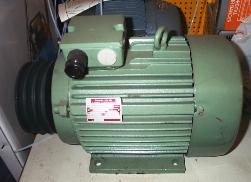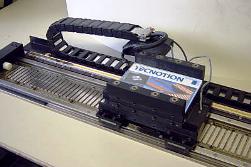Categories: Featured Articles » Novice electricians
Number of views: 73460
Comments on the article: 7
What you need to know about modern electric motors
The article discusses various types of electric motors, their advantages and disadvantages, development prospects.
Types of electric motors
 Electric motors, at present, are an indispensable component of any production. In utilities and in everyday life, they are also used very often. For example, these are fans, air conditioners, pumps for heating, etc. Therefore, a modern electrician needs to be well versed in the types and design of these units.
Electric motors, at present, are an indispensable component of any production. In utilities and in everyday life, they are also used very often. For example, these are fans, air conditioners, pumps for heating, etc. Therefore, a modern electrician needs to be well versed in the types and design of these units.
So, we list the most common types of electric motors:
1. DC motors, with a permanent magnet anchor;
2. DC motors, with an armature having an excitation winding;
3. Synchronous AC motors;
4. AC induction motors;
5. Servomotors;
6. Linear induction motors;
7. Motor rollers, ie rollers inside which electric motors with gears are located;
8. Valve motors.
DC motors
This type of motor was previously used very widely, but at present it is almost completely replaced by asynchronous electric motors, due to the comparative cheapness of the application of the latter. A new direction in the development of DC motors are DC valve motors with a permanent magnet armature.
Synchronous motors
Synchronous electric motors are often used for various types of drives operating at a constant speed, i.e. for fans, compressors, pumps, DC generators, etc. These are engines with a power of 20 - 10,000 kW, for rotation speeds of 125 - 1000 rpm.
Motors differ from generators in the presence of a rotor, necessary for asynchronous start-up, an additional short-circuited winding, as well as a relatively smaller gap between the stator and rotor.
Synchronous motors have efficiency higher, and the mass per unit of power is less than that of asynchronous ones at the same speed of rotation. A valuable feature of a synchronous motor compared to an asynchronous motor is the ability to regulate it reactive current, i.e. cosφ due to a change in the excitation current of the armature winding. Thus, it is possible to make cosφ close to unity in all operating ranges and, thereby, increase the efficiency and reduce losses in the power supply network.
Induction motors
 Currently, this is the most commonly used type of engine. An asynchronous motor is an alternating current motor whose rotor speed is lower than the rotational speed of the magnetic field created by the stator.
Currently, this is the most commonly used type of engine. An asynchronous motor is an alternating current motor whose rotor speed is lower than the rotational speed of the magnetic field created by the stator.
By changing the frequency and duty cycle of the voltage supplied to the stator, it is possible to change the rotation speed and moment on the motor shaft. The most commonly used squirrel cage induction motors. The rotor is made of aluminum, which reduces its weight and cost.
The main advantages of such engines are its low price and low weight. Repairing this type of electric motor is relatively simple and cheap.
The main disadvantages are a small starting torque on the shaft and a large starting current 3-5 times higher than the working one. Another big drawback of an induction motor is its low efficiency in partial load mode. For example, at a load of 30% of the nominal, the efficiency can drop from 90% to 40-60%!
The main way to deal with the disadvantages of an induction motor is to use a frequency drive. Frequency drive converts mains voltage 220 / 380V into a pulse voltage of variable frequency and duty cycle. Thus, it is possible to widely change the speed and torque on the motor shaft and get rid of almost all of its inherent flaws.The only "fly in the ointment" in this "barrel of honey" is the high price of the frequency drive, but in practice all the costs pay off within a year!
Servomotors
These engines occupy a special niche; they are used where precision changes in position and speed are required. These are space technology, robotics, CNC machines, etc.
Such engines are distinguished by the use of small diameter anchors, as small diameter is light weight. Due to the low weight, it is possible to achieve maximum acceleration, i.e. fast movements. These engines usually have a feedback sensor system, which allows to increase the accuracy of movement and implement complex algorithms for the movement and interaction of various systems.
Linear Induction Motors
 A linear induction motor creates a magnetic field that moves the plate in the motor. The accuracy of movement can be 0.03 mm per meter of movement, which is three times less than the thickness of a human hair! Usually a plate (slider) is attached to a mechanism that must be moved.
A linear induction motor creates a magnetic field that moves the plate in the motor. The accuracy of movement can be 0.03 mm per meter of movement, which is three times less than the thickness of a human hair! Usually a plate (slider) is attached to a mechanism that must be moved.
Such engines have a very high travel speed (up to 5 m / s), and therefore high performance. Movement speed and step can be changed. Since the engine has a minimum of moving parts, it has high reliability.
Motor rollers
The design of such rollers is quite simple: inside the drive roller is a miniature DC motor and gearbox. Motor rollers are used on various conveyors and sorting lines.
The advantages of motor-rollers are a low noise level, higher efficiency compared to an external drive, the motor-roller practically does not require maintenance, since it only works when you need to move the conveyor, its resource is very large. When such a roller fails, it can be replaced by another in the shortest possible time.
Valve motors
A valve is called any engine in which the regulation of operating modes is performed using semiconductor (valve) converters. As a rule, this is a synchronous motor with excitation from permanent magnets. The motor stator is controlled by an inverter with microprocessor control. The engine is equipped with a sensor system to provide feedback on position, speed and acceleration.
 The main advantages of valve electric motors are:
The main advantages of valve electric motors are:
1. Contactlessness and lack of nodes requiring maintenance,
2. High resource;
3. A large starting torque and a large overload capacity of the moment (5 or more times);
4. High performance transients;
5. A huge range of adjustments for speed of 1: 10000 or more, which is at least two orders of magnitude higher than that of asynchronous motors;
6. The best indicators for efficiency and cosφ, their efficiency at all loads exceeds 90%. At the same time, asynchronous motors, the efficiency at half loads can drop to 40-60%!
7. Minimum open-circuit currents and inrush currents;
8. Minimum weight and size indicators;
9. The minimum payback period.
By design features, such motors are divided into two main types: non-contact DC and AC motors.
The main direction of improving valve motors at the moment is the development of adaptive sensorless control algorithms. This will reduce the cost and increase the reliability of such drives.
In such a small article, of course, it is impossible to reflect all aspects of the development of electric drive systems, because This is a very interesting and rapidly developing area in technology. The annual electrical engineering exhibitions clearly demonstrate the constant growth in the number of companies seeking to master this area. The leaders of this market, as always, are Siemens AG, General Electric, Bosch Rexroth AG, Ansaldo, Fanuc, etc.
See also at i.electricianexp.com
:
